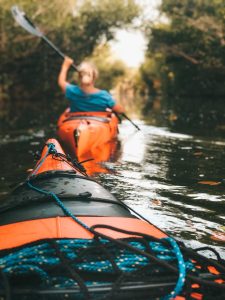Canoeing is a recreational activity that can provide a therapeutic experience. It involves paddling through water bodies using a canoe or kayak. The calming effect of water combined with the natural surroundings creates an immersive experience that can alleviate stress, anxiety, and depression. Nature-informed therapy integrates the healing power of nature into the therapeutic process. In this blog post, we will explore how canoeing could be therapeutic within the framework of nature-informed therapy.
Canoeing as a Therapeutic Activity
 The rhythmic motion of paddling through the water creates a sense of calmness and relaxation. The sound of water flowing, the breeze blowing, and the birds chirping, provide a sensory experience that can help reduce anxiety and stress. Canoeing can also promote mindfulness as it requires focus and attention to maintain balance and navigate through the water. Canoeing in the great outdoors can be an immersive experience that combines the therapeutic benefits of nature with the adventure of exploration. It can provide an opportunity to disconnect from technology and the stresses of daily life and reconnect with nature. Canoeing through the wilderness can also foster a sense of self-reliance, teamwork, and personal growth as it requires problem-solving skills and physical endurance.
The rhythmic motion of paddling through the water creates a sense of calmness and relaxation. The sound of water flowing, the breeze blowing, and the birds chirping, provide a sensory experience that can help reduce anxiety and stress. Canoeing can also promote mindfulness as it requires focus and attention to maintain balance and navigate through the water. Canoeing in the great outdoors can be an immersive experience that combines the therapeutic benefits of nature with the adventure of exploration. It can provide an opportunity to disconnect from technology and the stresses of daily life and reconnect with nature. Canoeing through the wilderness can also foster a sense of self-reliance, teamwork, and personal growth as it requires problem-solving skills and physical endurance.
Canoeing in the wilderness
It requires a set of skills and competencies that go beyond paddling. It involves navigation, problem-solving, decision-making, and risk management skills. The experience of canoeing in the wilderness can promote self-reliance, teamwork, and personal growth by offering opportunities to develop and practice these skills.
Self-Reliance and Self-efficacy
Canoeing in the wilderness requires self-reliance as there are no support systems available. Canoeists must be self-sufficient and equipped to handle unexpected situations. They must be able to navigate the waterways, identify potential hazards, and make decisions on their own. The experience of canoeing in the wilderness can promote self-reliance as it requires individuals to rely on themselves and their skills to complete the journey.
Teamwork and Sense of Belonging
Canoeing in the wilderness can also promote teamwork. Canoeing requires coordination between the paddlers to maintain balance and direction. In the wilderness, paddlers must work together to navigate around obstacles, portage, and camp. The experience of canoeing in the wilderness can promote teamwork as it requires individuals to work together to achieve a common goal.
Personal Growth, Self-esteem and Confidence
Canoeing in the wilderness can also promote personal growth. The experience of canoeing in the wilderness can challenge individuals physically and mentally, pushing them out of their comfort zone. Canoeists may face unexpected challenges and must learn to adapt and problem-solve. They may also gain a sense of accomplishment and self-confidence as they overcome obstacles and achieve their goals. The experience of canoeing in the wilderness can promote personal growth as it offers opportunities to develop new skills, overcome challenges, and gain a sense of self-efficacy.
and gain a sense of accomplishment. The natural environment can also have a therapeutic effect on individuals, promoting relaxation, mindfulness, and stress reduction. Canoeing in the wilderness is not only an adventure, but it can also be a form of nature-informed therapy that promotes holistic well-being.
Conclusion
Canoeing can be a therapeutic activity that promotes mindfulness, stress reduction and personal growth. Within the framework of nature-informed therapy, canoeing can provide an immersive experience that integrates the healing power of nature into the therapeutic process. Canoeing in the wilderness can be an adventure that promotes self-reliance, inclusion and a sense of accomplishment. So, if you are looking for a therapeutic activity that combines the healing power of nature and the adventure of exploration, consider taking a canoeing trip.


